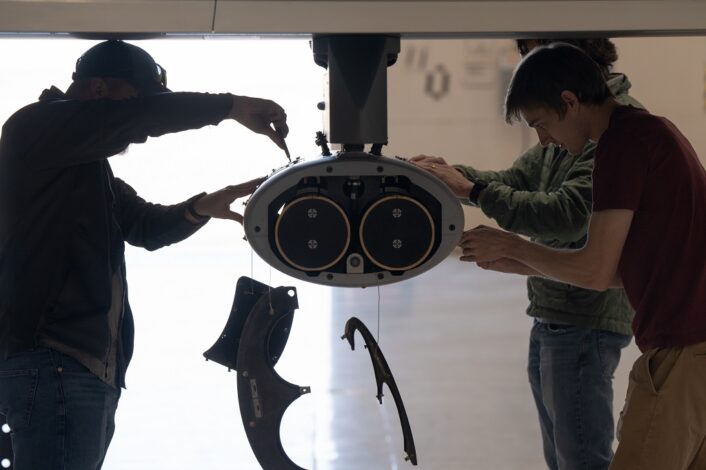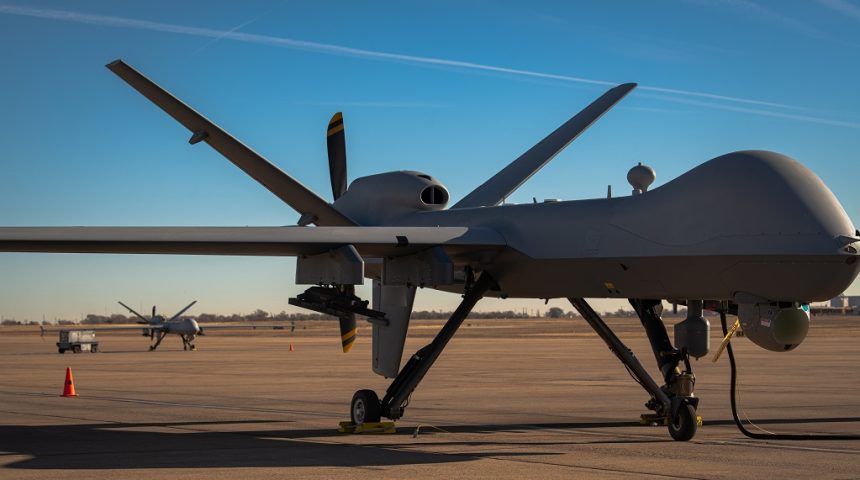The test is part of the Adaptive Airborne Enterprise concept development, which also demonstrated the Reaper’s capability to release an Altius 600 sUAS from a launch pod.
The U.S. Air Force 27th Special Operation Wing recently disclosed the successful demonstrations of new capabilities for the Remotely Piloted Aircraft community throughout December 2023. The demos are part of Air Force Special Operations Command’s Adaptive Airborne Enterprise (A2E) development, which envision an evolution beyond using the MQ-9 Reaper exclusively for Intelligence, Surveillance and Reconnaissance (ISR) and strike operations.
“Adaptive Airborne Enterprise is vital to thickening the Joint Force kill web throughout the spectrum of conflict and continues to be AFSOC’s #1 acquisition priority,” said Lt. Gen. Tony Bauernfeind, AFSOC commander. “Our Air Commandos are incredibly innovative, capable, and driven…they are bringing A2E to life. We will continuously develop the concept to full capability through multiple demonstrations over the next few years.”
The demos were performed in partnership with General Atomics and Anduril at Cannon Air Force Base and Melrose Air Force Range, in New Mexico. “We have established a great partnership with AFSOC,” said David R. Alexander, president of GA-ASI. “We know our RPA will be a key building block for AFSOC to achieve its A2E vision.”
The first demonstration saw a single 27th SOW RPA standard crew of a pilot and sensor operator simultaneously controlling three MQ-9As using a single, government-owned common control interface, the AFSOC RPA Control Suite (ARCS). ARCS adds additional capability to the Ground Control Station (GCS), by allowing a standard crew to control multiple UAS platforms.
The three MQ-9As were launched by using SATCOM Launch & Recovery (SLR) with GA-ASI’s Portable Aircraft Control Stations (PACS) and Ground Control Stations. Once airborne, control for the three MQ-9A was handed from the three GCS to a single ARCS workstation. Control of all three aircraft was handed back from ARCS to each GCS and the three aircraft performed SATCOM landings via GA-ASI’s Automatic Takeoff and Landing Capability (ATLC).
“These demonstrations were what we needed to really start to make A2E a reality,” said AFSOC Col. Trey Olman. “This was the first time we were able to demonstrate control of multiple RPAs from a single workstation, which is important in reducing manpower requirements.”
The second demonstration saw an MQ-9 releasing two Altius 600 small unmanned aircraft system (sUAS) from a specially designed launch pod and controlling them with an additional crew member. The command is in fact looking to acquire the capability to direct sUASs carrying standoff sensor payloads, with crews able to control swarms of air vehicles from anywhere.

As directed in the 2022 U.S. National Defense Strategy, AFSOC has shifted its priority from Counter-Violent Extremist Organization operations to also being capable of countering near-peer and peer adversaries in contested or denied environments. A2E is broken into five phases, with the first three phases currently underway.
In phase one, AFSOC aims to transition to a government-owned UAS command and control interface, such as the ARCS tested in December, replacing the stationary RPA control system. The new A2E interface will shrink a traditional RPA crew’s deployed footprint and provide operators with the flexibility and mobility to fly various aircraft from austere locations – whether operating from the back of an AC-130, home station, or even urban environments.
“In the future, we’d like to take this from where we’ve fought in the past, a more permissive environment, to contested and denied spaces,” said U.S. Air Force Maj. Lindsay Scott, AFSOC Headquarters Rapid Capabilities Development Chief of Autonomous Capabilities. “Our goal is to ensure we are always bringing effects to the battle space.”
In phase two, AFSOC’s objective is creating the capability for a single crew to fly multiple MQ-9s simultaneously. According to the director of the 27th Special Operations Group’s RPA Operations Center, U.S. Air Force Maj. Joshua Radford, AFSOC plans to evolve past the historical standard of one crew operating one aircraft, the status quo for MQ-9 operations.
Phase three entails a single crew controlling multiple types of UASs, ranging from Group 1 sUAS like the RQ-11B Raven to larger Group 5 UASs like the MQ-9A Reaper. The Altius 600 tested in December falls in the Group 2 sUAS type.
In phase four, a single crew will control formations of UASs from mobile and austere locations, leading into the final phase: creating new effects-based ISR units. These units could be comprised of UASs, forward deployed ground forces, cyber operators and space operators that can collaboratively employ UAS capabilities in permissive, contested or denied environments.
AFSOC says the A2E demonstrations conducted in 2023 at Cannon AFB successfully validated many of the capabilities described in phases one through three. The first A2E sUAS collaboration exercise was in June 2023, when the 27th SOW hosted Exercise Talon Spear, where several industry and DoD partners integrated various systems, to include weapon systems, specific cameras, onboard computer systems and tactical situational awareness tools. The next A2E demonstration is planned for Summer 2024.
AFSOC is aiming to continue developing and procuring A2E-compatible platforms, allowing the MQ-9 to act as a “mothership” for sUAS and loitering munition command and control, as well as a data transport node for mesh networks. To do this, the command is also acquiring three MQ-9B SkyGuardian RPAs, becoming the type’s first U.S. customer.
The mesh networks will be used in concert with Artificial Intelligence technologies and an advanced Human Machine Interface, says the press release, allowing AFSOC crews to operate multiple large and small UASs simultaneously. This way they will be able to cover more terrain and prosecute more targets in environments that are not currently accessible, transforming the current AFSOC MQ-9 enterprise into the robust UAS architecture required to deliver specialized airpower to current and future fights.









